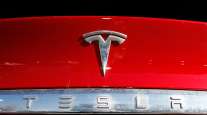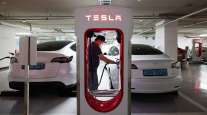Tesla’s Newest Promises Break the Laws of Batteries

Elon Musk knows how to make promises. Even by his own standards, the promises made last week while introducing two new Tesla vehicles—the heavy-duty Semi Truck and the speedy Roadster—are monuments of envelope pushing. To deliver, according to close observers of battery technology, Tesla would have to far exceed what is currently thought possible.
Take the Tesla Semi: Musk vowed it would haul an unprecedented 80,000 pounds for 500 miles on a single charge, then recharge 400 miles of range in 30 minutes. That would require, based on Bloomberg estimates, a charging system that’s 10 times more powerful than one of the fastest battery-charging networks on the road today—Tesla’s own Superchargers.
SPLASHY DEBUT: Tesla Semi's unveiling was a spectacle in itself
FLEETS LINE UP: Some fleets are making reservations to purchase
LIVEONWEB: How does electric fit in with the trucks of tomorrow?
The diminutive Tesla Roadster is promised to be the quickest production car ever built. But that achievement would mean squeezing into its tiny frame a battery twice as powerful as the largest battery currently available in an electric car.
These claims are so far beyond current industry standards for electric vehicles that they would require either advances in battery technology or a new understanding of how batteries are put to use, said Sam Jaffe, battery analyst for Cairn Energy Research in Boulder, Colorado. In some cases, experts suspect Tesla might be banking on technological improvements between now and the time when new vehicles are actually ready for delivery.
“I don’t think they’re lying,” Jaffe said. “I just think they left something out of the public reveal that would have explained how these numbers work.”
Here are four of Tesla’s most provocative battery claims—and an attempt to puzzle out how they might be achieved.
Truck Range: Haul 80,000 Pounds for 500 Miles
When Musk took the stage in an airport hangar in Hawthorne, California, his first proclamation was the Tesla Semi’s range: A fully-loaded truck would be able to travel at highway speeds for 500 miles. The previous record-holder, unveiled by Daimler in October, is a truck that maxes out at 220 miles.
A heavy-duty, long-range truck is the toughest vehicle to electrify while still turning a profit, said Menahem Anderman, president of Total Battery Consulting Inc., in Oregon House, California. Tesla may be doing it to prove a point. “If you can make a semi truck with batteries,” Anderman said, “then you can make everything else with batteries.”

Tesla
Tesla is making its trucks more efficient by reducing wind drag to levels that are comparable to those of sports cars. But even if Tesla achieves record-breaking efficiency for the truck, it would still require a battery capacity somewhere from 600 kilowatt hours to 1,000 kilowatt hours to deliver on Musk’s claims, according to estimates from Bloomberg New Energy Finance. Split the difference, at 800 kWh, and it would mean a battery that weighs more than 10,000 pounds and costs more than $100,000—even before you build the truck around it. Tesla has priced the truck with 500-mile range at $180,000, less than the estimated prices of seven analysts surveyed by Bloomberg, and says fuel savings will result in a two-year payback when compared to diesel.
One thing Tesla has going for it is the falling price of batteries. Musk may be banking on battery improvements between now to the early 2020s in order for its truck to make financial sense. The first Tesla Semis won’t hit the road until late 2019; even then, production would probably start slowly. Most fleet operators will want to test the trucks before considering going all-in. By the time Tesla gets large orders, batteries should cost considerably less.

A new, 40-stall Supercharger station and customer lounge in Kettleman, California. Tesla
Tesla Megachargers: 400 Miles in 30 Minutes
Musk’s claim that the truck will be able to accumulate 400 miles of charge in 30 minutes would allow the Semi to achieve the first true long-haul ranges in the industry. A driver might start the day with 500 miles of range, top off the battery at lunch, and be able to complete driving the U.S. legal limit of 11 hours in a day with range to spare. But doing so would require a charger unlike anything seen before.
“I don’t understand how that works,” said Salim Morsy, electric vehicle analyst at Bloomberg New Energy Finance. “I really don’t.” Tesla is claiming charging speeds that are faster than anything available now, and its customers will pay well below average market rates to access the network.
Tesla’s current generation of high-speed Superchargers have a power output of 120 kilowatts and can add about 180 miles to the battery in a Model S sedan in 30 minutes. But that’s for a passenger car, not a loaded truck. To meet Tesla’s claim of 400 miles in 30 minutes for a semi carrying 80,000 pounds would require its new Megachargers to achieve output of more than 1200 kW—or more than 10 times better than Tesla’s fastest chargers available today.
Joe Fath, fund manager for T. Rowe Price Group Inc., Tesla’s seventh-largest shareholder, said that prior to the unveiling he thought Tesla’s heavy-duty truck might be able to address about a quarter of the hauling tasks performed by the largest heavy-duty freight trucks, known as Class 8 semis. In North America alone, these big trucks account for about $30 billion in sales each year, according to industry data tracked by Bloomberg.
The promises in Musk’s presentation persuaded Fath that Tesla will be able to compete in nearly two-thirds of the Class 8 market. “If they execute,” he said, “they have a very big opportunity.”
Guaranteed Charging Rates of 7 Cents per kWh
The sticker price of any electric truck, regardless of size, is going to be higher than its diesel equivalent because of the batteries, which alone can cost as much as some standard diesel trucks. The $180,000 Tesla Semi will compete with diesels that cost as little as $100,000. The trick is to offset those higher upfront costs through lower maintenance and fuel savings.

Tesla
Perhaps Tesla’s most head-scratching revelation is that it will guarantee truckers electricity rates of 7 cents per kilowatt hour. That could result in fuels savings of more than $30,000 a year for some truckers, according to Bloomberg estimates. Partly, Musk said, this will be done by adding solar power and massive battery packs at the charging stations.
While the economics of such a plan vary by region, under any scenario that BNEF’s Morsy expects, Tesla will be heavily subsidizing those electricity rates for customers. He estimated that Tesla will pay a minimum of 40 cents per kilowatt hour, on average, for every 7 cents paid by a trucking company.
“There’s no way you can reconcile 7 cents a kilowatt hour with anything on the grid that puts a megawatt hour of energy into a battery,” Morsy said. “That simply does not exist.”
That may sound like a disastrous financial plan, but it’s no different from what Tesla does for its current Supercharger network. Tesla offers free electricity to most of its Model S and Model X customers while paying almost $1 per kilowatt hour to produce it, Morsy said. That amounts to a subsidy of as much as $1,000 per car in 2017.
Many electric utilities base their commercial rates on the peak amount of electricity that a customer draws at one time, even if that peak occurs only for a brief period. Tesla’s Megacharger stations would incur extremely high charges by drawing so much power so quickly. The best chance for mitigating those charges are to build Megachargers at existing truck terminals that already draw a lot of power, Morsy said, and by adding massive battery packs that can spread demand over time.
From another perspective, these subsidies to support Megachargers could be a boon to Tesla’s balance sheet as it wades into an entirely new industry. It allows the company to maximize its upfront revenue by charging a lot for the trucks while spreading out the cost of building and operating the charging network over time.





